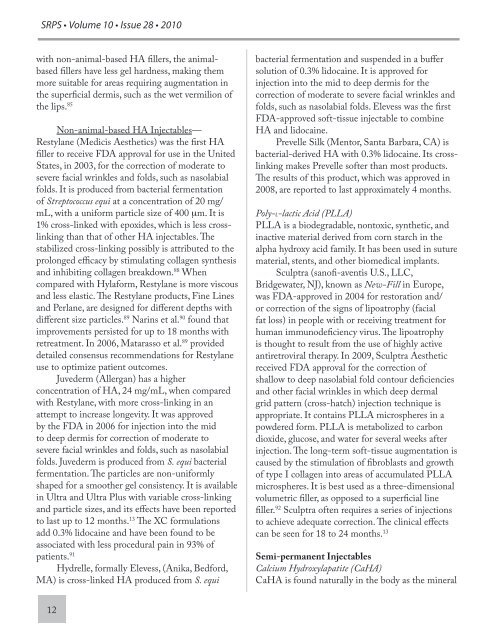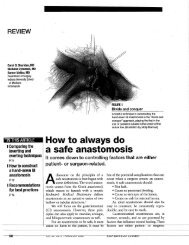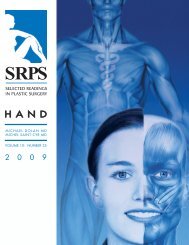Injectables - Plastic Surgery Internal
Injectables - Plastic Surgery Internal
Injectables - Plastic Surgery Internal
You also want an ePaper? Increase the reach of your titles
YUMPU automatically turns print PDFs into web optimized ePapers that Google loves.
SRPS • Volume 10 • Issue 28 • 2010<br />
with non-animal-based HA fillers, the animalbased<br />
fillers have less gel hardness, making them<br />
more suitable for areas requiring augmentation in<br />
the superficial dermis, such as the wet vermilion of<br />
the lips. 85<br />
Non-animal-based HA <strong>Injectables</strong>—<br />
Restylane (Medicis Aesthetics) was the first HA<br />
filler to receive FDA approval for use in the United<br />
States, in 2003, for the correction of moderate to<br />
severe facial wrinkles and folds, such as nasolabial<br />
folds. It is produced from bacterial fermentation<br />
of Streptococcus equi at a concentration of 20 mg/<br />
mL, with a uniform particle size of 400 mm. It is<br />
1% cross-linked with epoxides, which is less crosslinking<br />
than that of other HA injectables. The<br />
stabilized cross-linking possibly is attributed to the<br />
prolonged efficacy by stimulating collagen synthesis<br />
and inhibiting collagen breakdown. 88 When<br />
compared with Hylaform, Restylane is more viscous<br />
and less elastic. The Restylane products, Fine Lines<br />
and Perlane, are designed for different depths with<br />
different size particles. 89 Narins et al. 90 found that<br />
improvements persisted for up to 18 months with<br />
retreatment. In 2006, Matarasso et al. 89 provided<br />
detailed consensus recommendations for Restylane<br />
use to optimize patient outcomes.<br />
Juvederm (Allergan) has a higher<br />
concentration of HA, 24 mg/mL, when compared<br />
with Restylane, with more cross-linking in an<br />
attempt to increase longevity. It was approved<br />
by the FDA in 2006 for injection into the mid<br />
to deep dermis for correction of moderate to<br />
severe facial wrinkles and folds, such as nasolabial<br />
folds. Juvederm is produced from S. equi bacterial<br />
fermentation. The particles are non-uniformly<br />
shaped for a smoother gel consistency. It is available<br />
in Ultra and Ultra Plus with variable cross-linking<br />
and particle sizes, and its effects have been reported<br />
to last up to 12 months. 13 The XC formulations<br />
add 0.3% lidocaine and have been found to be<br />
associated with less procedural pain in 93% of<br />
patients. 91<br />
Hydrelle, formally Elevess, (Anika, Bedford,<br />
MA) is cross-linked HA produced from S. equi<br />
12<br />
bacterial fermentation and suspended in a buffer<br />
solution of 0.3% lidocaine. It is approved for<br />
injection into the mid to deep dermis for the<br />
correction of moderate to severe facial wrinkles and<br />
folds, such as nasolabial folds. Elevess was the first<br />
FDA-approved soft-tissue injectable to combine<br />
HA and lidocaine.<br />
Prevelle Silk (Mentor, Santa Barbara, CA) is<br />
bacterial-derived HA with 0.3% lidocaine. Its crosslinking<br />
makes Prevelle softer than most products.<br />
The results of this product, which was approved in<br />
2008, are reported to last approximately 4 months.<br />
Poly-l-lactic Acid (PLLA)<br />
PLLA is a biodegradable, nontoxic, synthetic, and<br />
inactive material derived from corn starch in the<br />
alpha hydroxy acid family. It has been used in suture<br />
material, stents, and other biomedical implants.<br />
Sculptra (sanofi-aventis U.S., LLC,<br />
Bridgewater, NJ), known as New-Fill in Europe,<br />
was FDA-approved in 2004 for restoration and/<br />
or correction of the signs of lipoatrophy (facial<br />
fat loss) in people with or receiving treatment for<br />
human immunodeficiency virus. The lipoatrophy<br />
is thought to result from the use of highly active<br />
antiretroviral therapy. In 2009, Sculptra Aesthetic<br />
received FDA approval for the correction of<br />
shallow to deep nasolabial fold contour deficiencies<br />
and other facial wrinkles in which deep dermal<br />
grid pattern (cross-hatch) injection technique is<br />
appropriate. It contains PLLA microspheres in a<br />
powdered form. PLLA is metabolized to carbon<br />
dioxide, glucose, and water for several weeks after<br />
injection. The long-term soft-tissue augmentation is<br />
caused by the stimulation of fibroblasts and growth<br />
of type I collagen into areas of accumulated PLLA<br />
microspheres. It is best used as a three-dimensional<br />
volumetric filler, as opposed to a superficial line<br />
filler. 92 Sculptra often requires a series of injections<br />
to achieve adequate correction. The clinical effects<br />
can be seen for 18 to 24 months. 13<br />
Semi-permanent <strong>Injectables</strong><br />
Calcium Hydroxylapatite (CaHA)<br />
CaHA is found naturally in the body as the mineral






